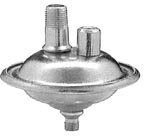


Shallow Well Systems
With a shallow well jet pump system, an air volume control (See Figure 1) is mounted on the side of the tank, and plumbed to the suction side of the jet pump with a small tube. When the pump turns on, reduced pressure created in the valve draws in a small charge of air, which is released into the tank when the pump shuts off. Because of the valve's design, it controls the water level by drawing in air from the tank or outside atmosphere depending on the level of water in the tank. These valves are very effective, but must be kept clean to function properly.
Deep Well Systems
The most common deep well air charging system consists of a bleeder orifice (Figure 2), a snifter valve (Figure 3), and an air release valve (Figure 4). The bleeder orifice, located in the drop pipe, around 10 or so feet below the well head, provides a drain port for water in the pipe between the tank and orifice, to drain through at the end of the pumping cycle. It is designed to seal when the pump is running and open when the pump shuts off.A snifter valve, typically mounted in a tapped check valve at the well head, lets air into the drop pipe so water can be released through the bleeder orifice. A snifter valve looks like a valve stem on a tire, but it has a very weak spring, or no spring, to function properly in this application.
At the beginning of the pumping cycle, air in the drop pipe between the snifter and bleeder is pushed into the pressure tank ahead of the water. More air is added each pump cycle than is needed to replenish air absorbed into the water, so a means of releasing excess air is needed.
Air release valves come in several configurations, and are mounted on the side of the tank, in the fitting provided. These are simply a float valve, similar to a toilet bowl float, which opens when the water level is below the float to let air escape and closes when the water level reaches the float.
One of the common failures in this type air charge system is a clogged snifter valve. Iron algae, calcium, or other minerals can foul the tiny opening, rendering the device inoperable. The problem can be easily remedied by replacing the core. Make sure the replacement core is designed for this application, with a weak spring, or no spring. A standard automobile or bicycle core will not work.
As with snifter valves, bad water is an air release valve's worst enemy. Minerals or iron bacteria can clog the air orifice or jam the float, rendering the air release system inoperable, leading to a water logged tank, or one with excessive air, which will inconvenience your customer, and may damage his pump and/or controls.
With the added maintenance, extra cost, and possible reduced drawdown of a conventional tank vs. captive air tank, why would someone choose the former over the latter? One good reason is the beneficial side of their biggest drawback, that they absorb air into the water. Air is an excellent oxidizer of iron, hydrogen sulfide, and other dissolved contaminants, so use of a conventional tank may eliminate need for a separate oxidation contact tank or chemical treatment to fix contaminated water.
Thanks to Brady Products for their help with art work used in this article. Next month we will switch gears and talk about how to build your own pump test station. Till thenÉ.


Report Abusive Comment